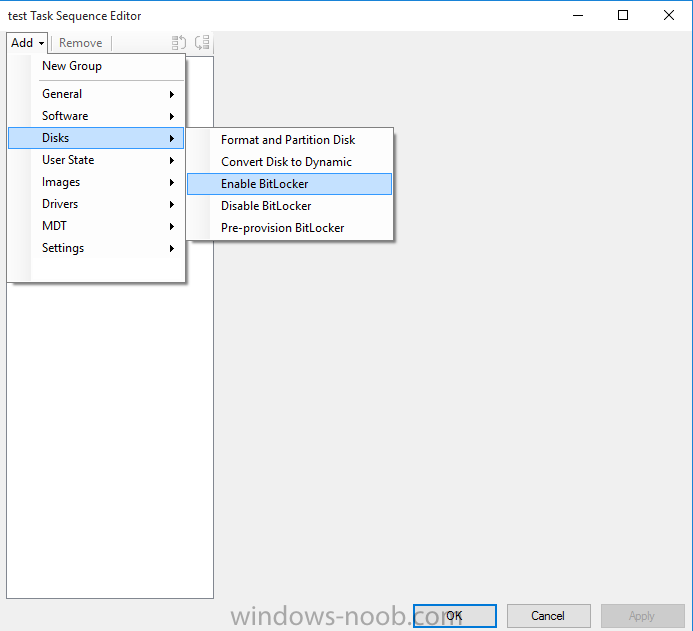-
Posts
9249 -
Joined
-
Last visited
-
Days Won
369
Everything posted by anyweb
-
to add to Peter's comment, simply upgrade configmgr to CM12 R2 SP1 or later and you'll be able to deploy drivers to Windows 10 in a supported way, anything prior to that version is not supported (but can work),
- 2 replies
-
- Windows 10
- SCCM 2012
-
(and 1 more)
Tagged with:
-

Deploying Bitlocker - Windows 10
anyweb replied to Silencer001's question in Deploying Windows 10, Windows 8.1, Windows 7 and more...
I havn't tried it specifically but i'd imagine it should work, try it and let us know -

Deploying Bitlocker - Windows 10
anyweb replied to Silencer001's question in Deploying Windows 10, Windows 8.1, Windows 7 and more...
Microsoft have made the scripts free to use (MDT) so why can't the customer use them ? re-inventing the wheel seems counterintuative -

Capturing an image - Nothing runs after Capture wizard
anyweb replied to welshslider's topic in Configuration Manager 2012
assuming you are using capture media to do this search for the smsts.log file and attach it here, why are you not building the image using MDT or ConfigMgr build and capture process ? -
Microsoft yesterday released Office 2016 for Windows. This marks a milestone in delivering new value for Office 365 subscribers with a focus on collaboration, apps that work for you, a perfect pairing with Windows 10, and security features businesses will love. It also marks a new model for delivery, where subscribers can expect to get more frequent updates with new features and improvements. Along with Office 2016 for Windows, today we are also releasing Office 2016 for Mac as a one-time purchase option, along with several new and enhanced Office 365 services. for details about the release see the official post here
-

Drivers not installing during TS deployment
anyweb replied to Siroj's topic in Configuration Manager 2012
yes it should install all applicable firmware updates, you can check the versions in device manager (Firmware) and compare it against the versions in the drivers released -
great to hear it ~!
-

Deploying Bitlocker - Windows 10
anyweb replied to Silencer001's question in Deploying Windows 10, Windows 8.1, Windows 7 and more...
so to understand your question you want to pre-provision bitlocker AFTER the os has laid down ? normally you pre-provision bitlocker at the beginning of the task sequence after formatting the disk to save time, why not use the built-in steps in a ConfigMgr task sequence for achieving this ? see screenshot below... -
you didnt mention what version of ConfigMgr you are using, if it's SCCM 2012 R2 SP1 then you've hit a bug that means the deployment needs to be rescheduled to a day before, if not, then can you post your smsts.log file pls
-

Deploying Bitlocker - Windows 10
anyweb replied to Silencer001's question in Deploying Windows 10, Windows 8.1, Windows 7 and more...
i'm deploying windows 10 with bitlocker right now, no need for the mbam client unless you want those features later, you can use pre-provision bitlocker and the enable bitlocker built in steps to do what you need -

Windows 10 deployment via WDS in VM
anyweb replied to ONeill's question in Deploying Windows 10, Windows 8.1, Windows 7 and more...
thanks for updating the post with the solution. -
Multiple issues related to XML processing: Application bundles returning error 87 Selecting a keyboard locale in the Deployment Wizard Deployments failing due to Unattend.xml errors ZTIPatches returning error "Object required (424)" Cleanup after image capture doesn't remove LTIBootstrap entry which should cover the error above (which i've removed from the post), so, make sure that after you've updated the version that you also update the new packages to your distribution points otherwise they'll still be using the old source.
-
do you have any other distribution points enabled for PXE ?
-
have you seen this yet ? http://www.windows-noob.com/forums/index.php?/topic/4683-using-sccm-2012-rc-in-a-lab-part-12-updating-an-operating-system-image-using-offline-servicing/
-

Windows 10 OSD & mouse/keyboard/F8 issues
anyweb replied to TimLancer's topic in Configuration Manager 2012
you didn't say what version of ConfigMgr you are using, and/or when exactly you are pressing F8, does the SMSTS.log file reveal the keypress (it should)




